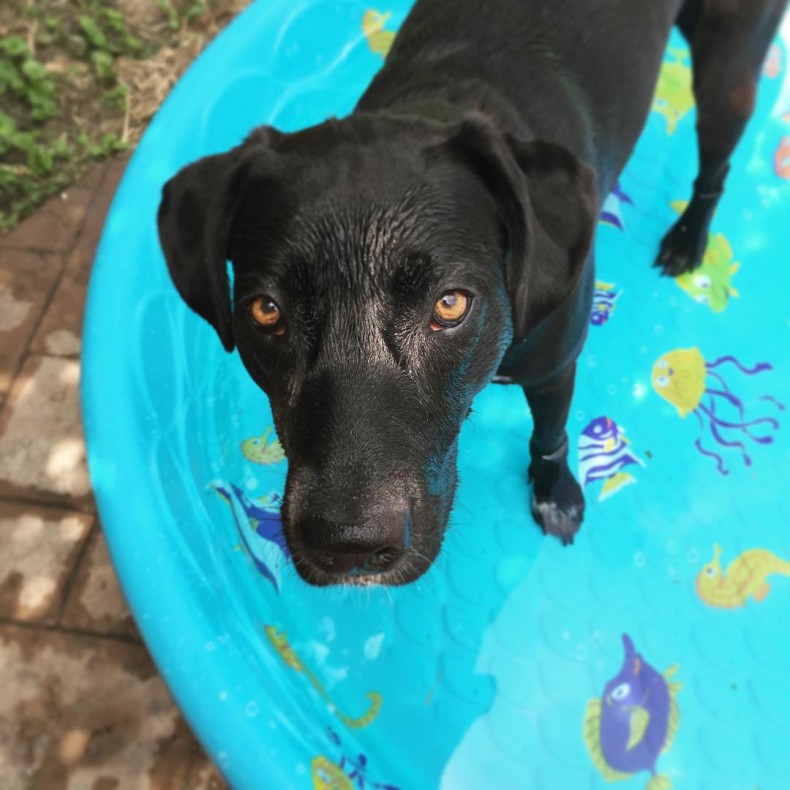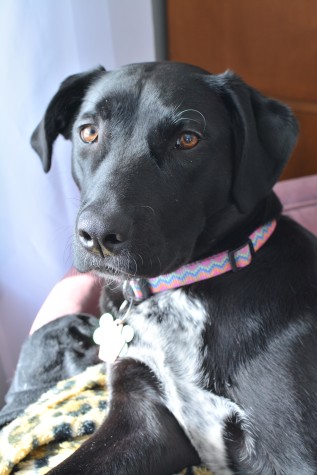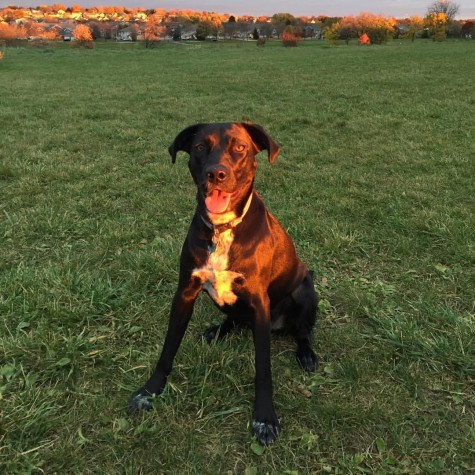Yesterday was National Dog Day, so I thought it only appropriate to repost this story about my dog and her insatiable appetite. She’s five now, and still insatiable.

Perhaps there was a time when our dog, Bea, didn’t eat everything. If so, I don’t remember it. At first, we thought it might be a puppy thing. But this month she turned two, and it seems clear that her insatiable appetite is a permanent part of her personality. Dogs aren’t known for their discriminating taste, but most dogs will balk at . . . well . . . something. Not my garbage dog. She is happiest when her mouth is full.
A partial list of things Bea has consumed (or tried to consume):
- a suede bootie (a real tragedy)
- a sack of whole wheat flour
- a sack of white flour
- an entire container of prenatal vitamins
- countless piles of dog poop (fresh and frozen)
- a pair of sunglasses
- a tube of hemp hand lotion
- a tub of sourdough starter
- a dirty diaper
- tree bark
- mulch
- compost
- dirty food containers
- dirty food wrappers
- any and all food scraps left in the soccer field by those litterbug high schoolers
- toilet paper
- kleenex
- half a morning bun off the counter
- crab grass
- sandpaper
- the fleece lining out of a pair of slippers
- a pair of mittens
- the plastic ends of shoelaces
- the eyes and noses of stuffed animals
- the face of my stuffed cat, a cherished childhood toy
- rocks that look like poop
- rocks that don’t look like poop
- rotten jack-o-lanterns
- bunny poop
- dead birds
The prenatal vitamins made her vomit. And so did the tree bark. But most of these items caused only mild intestinal distress or no symptoms at all. One thing, however, almost killed her.
A few months ago my husband and I went for a short walk. We took the baby, but left Bea at home. (My dad was on his way to pick the dog up — we’re not monsters!) Our actions were, naturally, quite upsetting. To add insult to injury, we stood in front of the house for many minutes conversing with the neighbors in full view of the dog, who no doubt had her nose pressed against the picture window. When we returned, the dog was gone — off to the dog park with my dad. But the evidence of her anger was plain to see: Her bed was littered with pill bottles. She hadn’t managed to pry open the Percocet, antibiotics, or ibuprofen. But the top to the vitamin D bottle had been transformed into a disk of mangled yellow plastic.
Here are the relevant facts: I had just given birth. My doctor recommended that I take 5,000 international units of vitamin D twice a day to make sure my breastmilk contained enough for my newborn daughter. Just a few days before the dog went on her rampage, I opened a bottle containing 90 pills. Save a few shiny capsules, the bottle was empty. A quick, back-of-the-envelope calculation convinced me that Bea had ingested about 400,000 international units. In other words, a shit-ton of vitamin D. It’s difficult to poison yourself with water-soluble vitamins, like vitamin C. The excess ends up in your urine. But vitamin D is fat soluble, meaning it stays in the body’s fat stores. The excess ends up in your liver. A quick Google search convinced me that the situation was dire.
The ASPCA runs a poison control hotline for animals, but unlike the human poison control hotline, consultations aren’t free. We called anyway. Get her to the emergency vet, they advised.
The vet made Bea vomit in the hope that some of the gel caps would still be in her stomach. But the vitamin D was gone. (They did, however, manage to recover a couple hunks of dog poop courtesy of her post-poisoning trip to the dog park.) The vet gave us good news and bad news. Fortunately there is a protocol for vitamin D poisoning in dogs. Unfortunately it is involved and very expensive.
Vitamin D gets metabolized into calcitriol, which boosts calcium and phosphorus concentrations in the blood by increasing the amount of calcium-binding protein in the gut and mobilizing calcium and phosphorus from the bones. Too much calcium and phosphorus in the blood can cause soft tissues like the kidney to mineralize and stop working properly.
Bea didn’t seem sick, but the symptoms of vitamin D poisoning can take a long time to manifest. Bea spent the first 26 hours at the vet. The team administered activated charcoal to clean up any leftover vitamin D, and fluids to flush excess calcium out of her system. We brought her home, she peed in the bed, and for the next three days we made daily visits to the vet so that he could monitor her kidney function. The protocol may have been laborious, but it seemed to work. Bea stayed healthy. The damage was confined to our bank account.
Why Bea chooses to eat things that don’t seem even remotely palatable is a bit of a mystery. “The dietary indiscretion, and lack of internal appetite control, may be one of the imponderable questions in veterinary medicine. Rarely is there a scientific reason for their dietary waverings. Theories regarding nutritional deficiencies, mineral imbalances and hormonal disease abound, but no scientific studies have documented a consistent disease that can explain this behavior,” writes vet Jon Geller. But the vitamin D incident demonstrates that, in Bea’s case, the problem is partly behavioral. She tends to ingest inappropriate things most often when she is upset or lonely or anxious.
Still, breed might also be a factor. She is part black lab, and labradors are known for being scavengers. In fact, the comments on an article titled “Why do labradors eat rubbish?” and its companion “How to stop your Labrador eating rubbish” suggest that Bea is not the worst offender.
Lenora writes, “Our beautiful yellow Lab, Morgan, will eat anything! She is the loveliest dog ever & we are sure she is committing passive suicide! If we are not vigilant with fabrics, trash, plastics, she will swallow them. Last year she ate a piece of corn cob, which I had sliced in medallions to serve. $3,000 later it was surgically removed from where it was blocking her small intestine.”
“Years back we had a male lab that consumed pretty much anything we had worn….socks, bras, undies…. Never chewed a hole in any of them. He could wad them up in a ball and swallow them faster than you could get to him,” writes Jack and Asa’s Mom.
And then there’s Emma G’s dog: “Today Monty, my 15 week old lab, squatted in the middle of the street and passed a squeaker from a toy he destructed while I was in the shower.”
Terko writes, “It all began with an innocent looking dead rat retrieval on our first trip to deep woods as a 4-month old puppy. Then there were secret compost-eating contests in our friends’ yard. There has been occasional dead bird show-offs on the beach and throughout his life there has been problem with feces of homeless people in the bushes of our daily city walks.”
These comments provide irrefutable proof that people are willing to overlook an awful lot when it comes to dogs. We can’t help but love them, garbage mouths and all.


For this very reason I nicknamed our 8 month Pyrenees/Analtolian Shepherd “Poubelle”, which is French for “trash can”. It is astonishing what dogs choose to ingest.
Good doggie!!